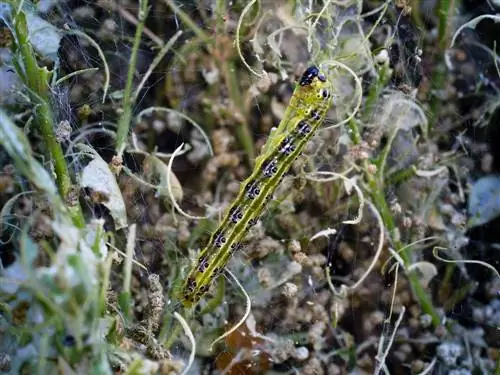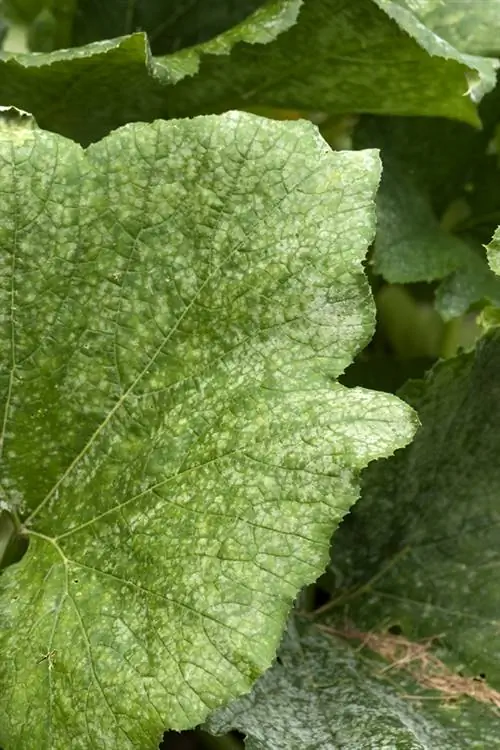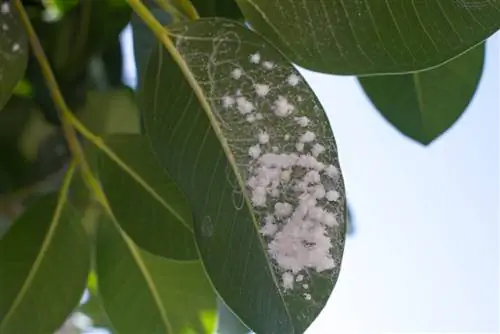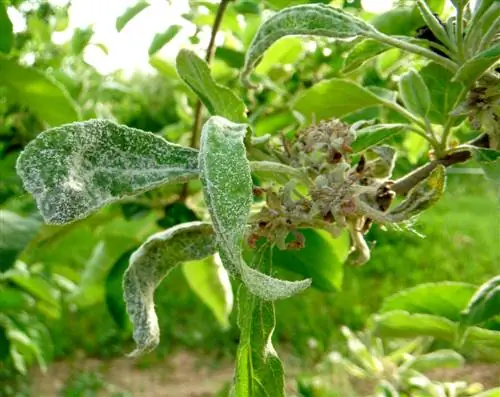- Author admin [email protected].
- Public 2023-12-16 16:46.
- Last modified 2025-01-23 11:21.
In 2007, an infestation with the box tree borer was reported for the first time. The butterfly, which was probably introduced from East Asia with plant imports, lays its eggs exclusively on boxwood, which its caterpillars, which often sit in hundreds on one plant, then eat bare. The pests are difficult to combat; in many cases, only chemical control helps. Before you use them, first try one of the following non-toxic home remedies.

How do I combat boxwood caterpillars with home remedies?
To combat boxwood caterpillars with home remedies, you can use close-meshed nets, high-pressure cleaners or vacuum cleaners, algae lime or opaque garbage bags. Repeat the application regularly to reduce infestation pressure and prevent new caterpillar populations.
Tight-meshed networks
The boxwood moth overwinters as an egg in a protective web inside the boxwood. As spring temperatures rise, the larvae hatch and immediately begin feeding. The first butterflies appear around May and prefer to lay their eggs on box trees that have not yet been infected. You can protect these in turn by draping tight-meshed nets over them - this makes it impossible for the butterfly to lay eggs and thus the next generation. However, since around two to three generations develop each year, the network would have to remain in place continuously between the beginning of March and the end of September. Of course, this looks visually less appealing.
High-pressure cleaner / vacuum cleaner
During the “boren borer season” between March and September, it is advisable to regularly check existing box trees for caterpillars and eggs. You should carefully pull apart the bushes and hedges and take a look inside, as the animals prefer to stay in the dark. In the event of a caterpillar infestation, cover the ground around the affected boxwood with foil or a tarpaulin and use a high-pressure cleaner. With this you blow or rinse the pests out of the plant and then all you have to do is pick up the pad with them and dispose of it. Alternatively, mechanical removal can also be done with a leaf blower or a vacuum cleaner. For the latter, you would need a joint attachment with which you can specifically vacuum the animals. But be careful: the caterpillars are surprisingly quick as soon as they sense vibrations. In addition, this measure must be repeated frequently, as new infestations can occur again and again.
Removing caterpillars with the high-pressure cleaner - Here's how it works:
- Lay the floor with foil, fleece or a tarpaulin
- weight these with stones or similar
- Treat plants with a high-pressure cleaner (€105.00 on Amazon) (or another suitable device)
- make sure that the caterpillars all land on the surface (and not in the grass or similar)
- Collect animals after just a few meters and often
- these can otherwise escape and infest the box trees again
Algae limestone
It has been known since 2016 that algae lime - a substance that is actually used for fertilization and soil improvement - is excellent against the box tree borer. In order to prevent an infestation orHowever, to contain them, you must dust all boxwoods with algae lime. This is not only visually unappealing, but also causes further problems:
- The leaves dusted with lime are no longer fully capable of photosynthesis.
- Algae lime blocks the stomata so that shoot growth is inhibited.
- The pH value of the soil becomes unbalanced due to frequent use.
- As a result, the absorption of nutrients becomes more difficult.
- The effects on the local insect and bird world have not yet been sufficiently researched.
In view of these findings, the use of algae lime should be carefully considered. However, if the infestation pressure is very high and you cannot control the plague otherwise, this remedy provides a good remedy. It also ensures that no new caterpillars hatch from eggs that have already been laid.
Opaque garbage bag
This method only works on hot and sunny days:
- Put a large, opaque plastic bag over an infected boxwood in the morning.
- Garbage bags are ideal for this.
- The cover should remain on the bush until the evening.
- A heat build-up occurs under the garbage bag, which causes the borer caterpillars to die.
- The box, on the other hand, usually survives the treatment without any consequences.
- Collect the caterpillars in the evening and dispose of them.
In order to have lasting success with the treatment, you should repeat it at regular intervals. The eggs do not die due to the heat, so new caterpillars can be found on the plant after a few days to weeks. However, over time you will reduce the infestation pressure, as fewer caterpillars also mean fewer egg-laying butterflies.
Tip
From March onwards, hang yellow panels or pheromone traps in the trees and bushes around box plantings. These do not reduce the butterfly population, but they clearly show you the presence of the pests. Once the first butterflies are caught, you can take immediate action.






